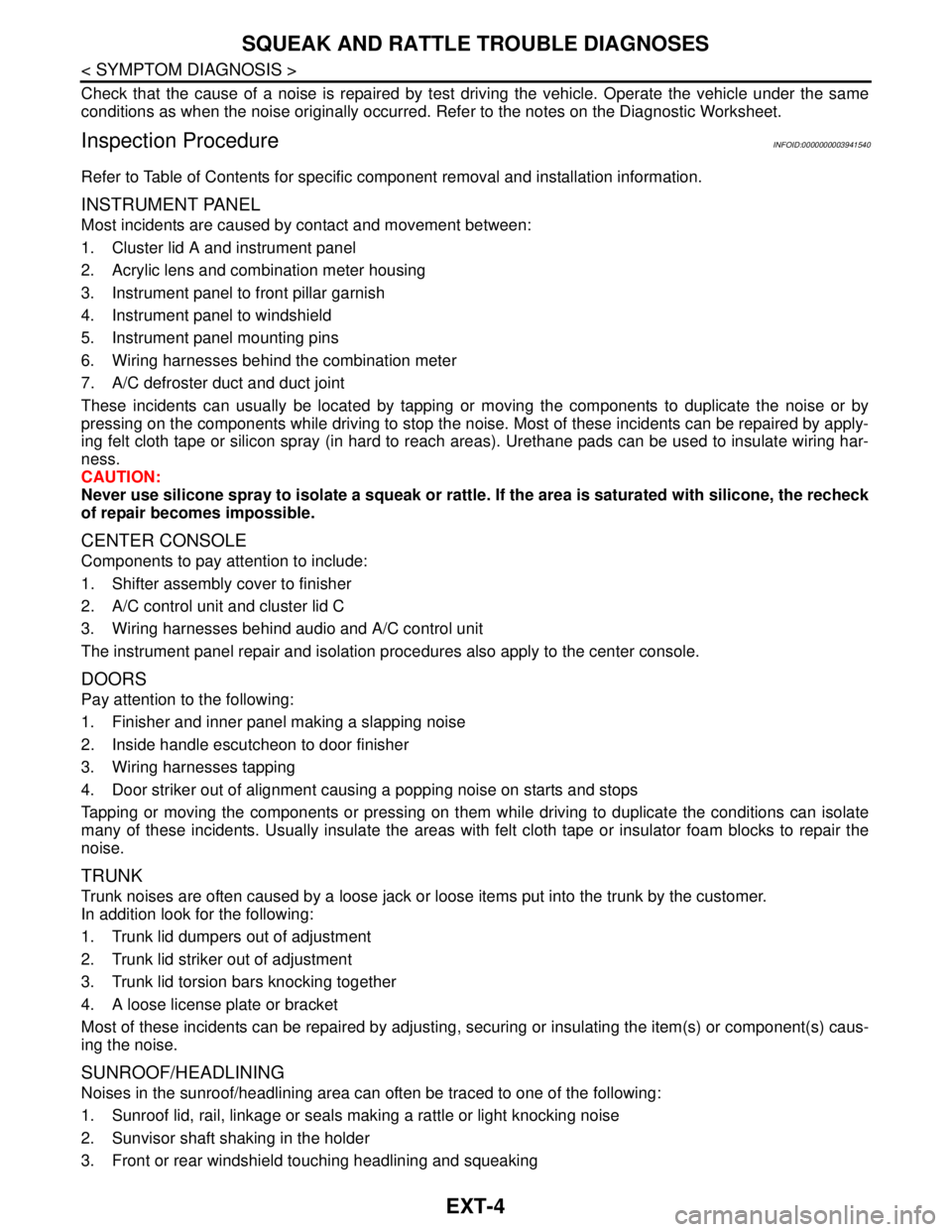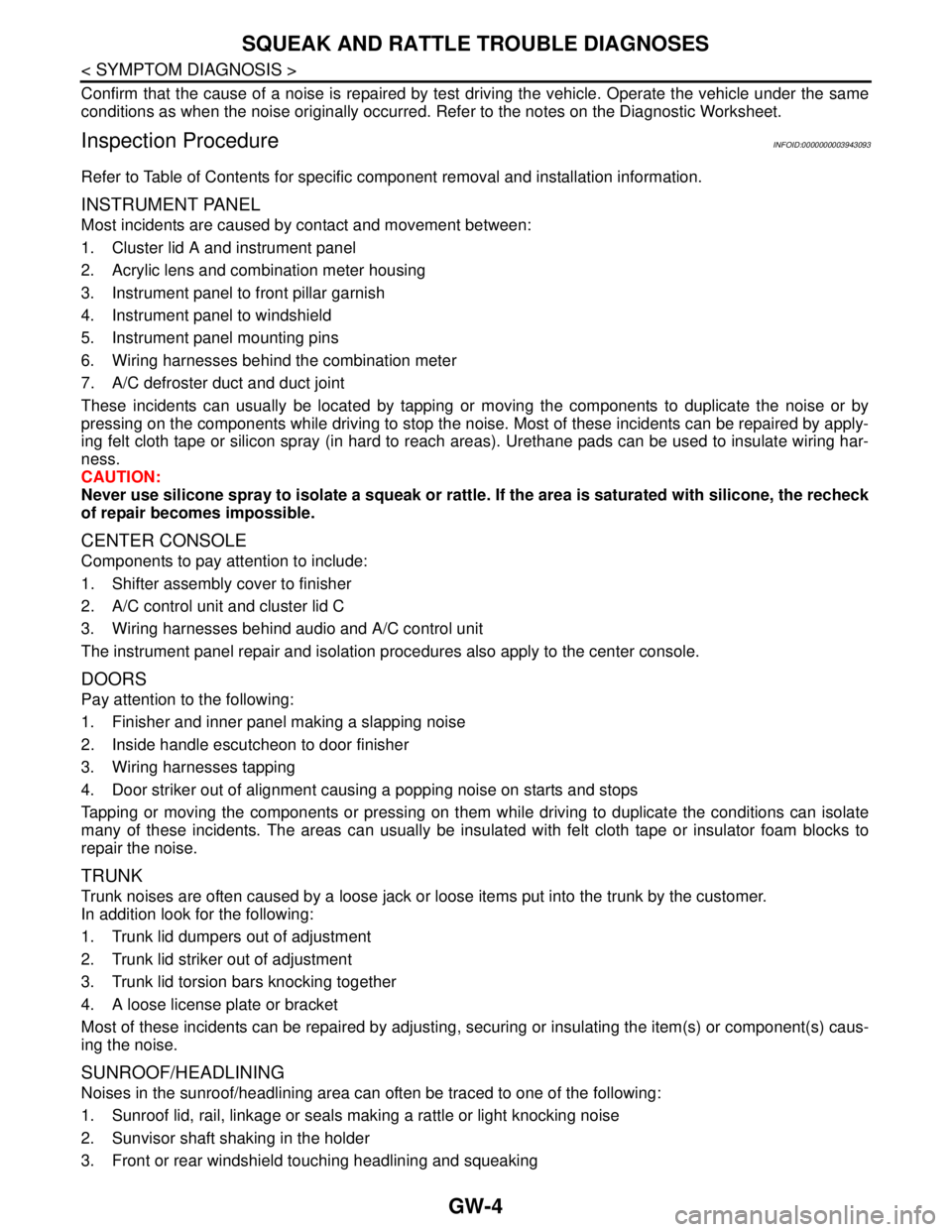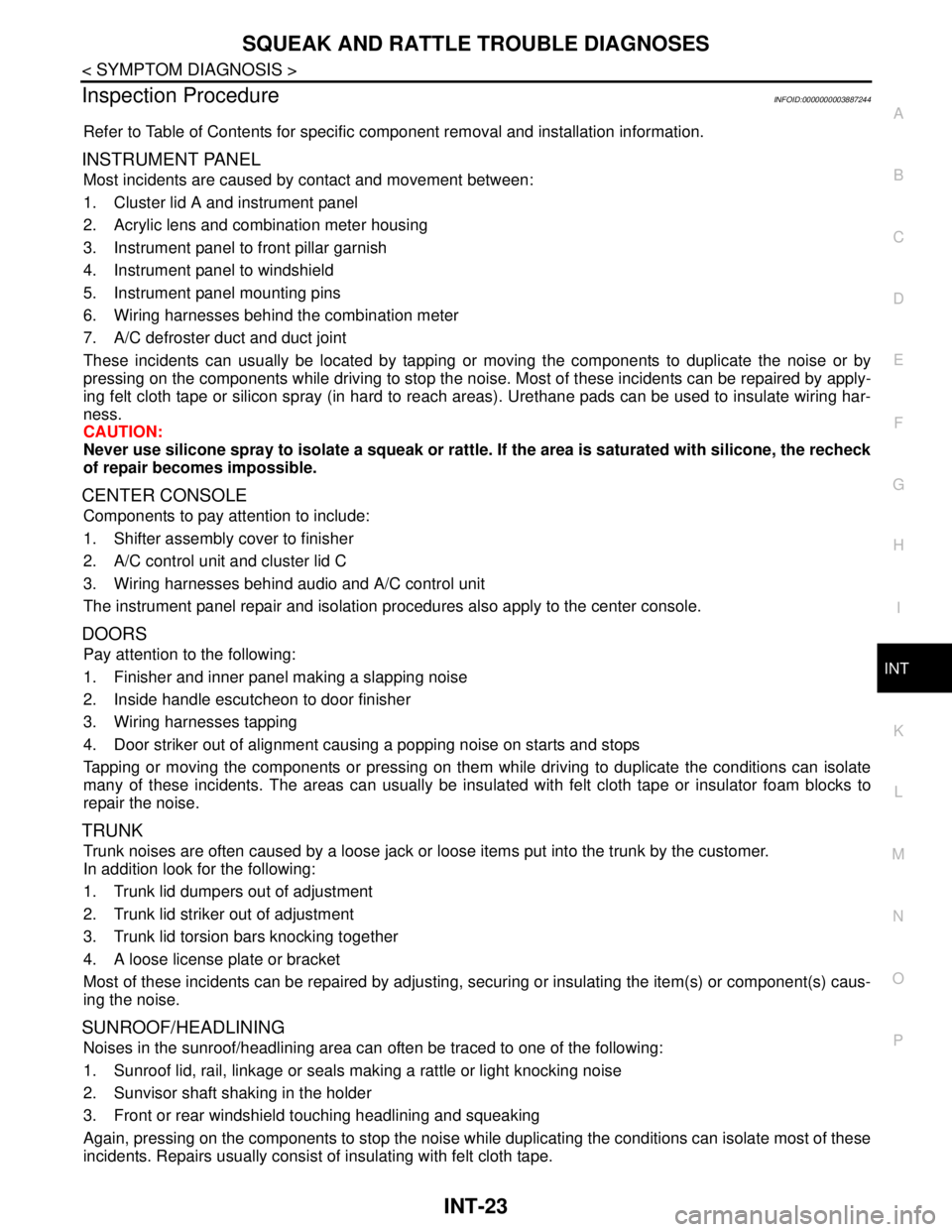2008 NISSAN TEANA instrument cluster
[x] Cancel search: instrument clusterPage 181 of 5121
![NISSAN TEANA 2008 Service Manual AV
AUDIO UNIT
AV-37
< ON-VEHICLE REPAIR >[AUDIO SYSTEM]
C
D
E
F
G
H
I
J
K
L
MB A
O
P
ON-VEHICLE REPAIR
AUDIO UNIT
Exploded ViewINFOID:0000000003765611
REMOVAL
Refer to IP-11, "Exploded View".
DISASSEM NISSAN TEANA 2008 Service Manual AV
AUDIO UNIT
AV-37
< ON-VEHICLE REPAIR >[AUDIO SYSTEM]
C
D
E
F
G
H
I
J
K
L
MB A
O
P
ON-VEHICLE REPAIR
AUDIO UNIT
Exploded ViewINFOID:0000000003765611
REMOVAL
Refer to IP-11, "Exploded View".
DISASSEM](/manual-img/5/57391/w960_57391-180.png)
AV
AUDIO UNIT
AV-37
< ON-VEHICLE REPAIR >[AUDIO SYSTEM]
C
D
E
F
G
H
I
J
K
L
MB A
O
P
ON-VEHICLE REPAIR
AUDIO UNIT
Exploded ViewINFOID:0000000003765611
REMOVAL
Refer to IP-11, "Exploded View".
DISASSEMBLY
Removal and InstallationINFOID:0000000003765612
REMOVAL
1. Remove instrument finisher C. Refer to IP-12, "Removal and Installation".
2. Remove cluster lid D. Refer to IP-12, "
Removal and Installation".
3. Remove audio unit with an A/C auto amp. as a single unit from the body.
4. Remove bracket screws, and then remove audio unit.
INSTALLATION
Install in the reverse order of removal.
1. Audio unit 2. Bracket LH 3. A/C auto amp.
4. Bracket RH
JPNIA1027ZZ
Page 314 of 5121
![NISSAN TEANA 2008 Service Manual AV-170
< ON-VEHICLE REPAIR >[BASE AUDIO AND DISPLAY SYSTEM]
AV CONTROL UNIT
ON-VEHICLE REPAIR
AV CONTROL UNIT
Exploded ViewINFOID:0000000003940154
REMOVAL
Refer to IP-11, "Exploded View".
DISASSEMBLY
NISSAN TEANA 2008 Service Manual AV-170
< ON-VEHICLE REPAIR >[BASE AUDIO AND DISPLAY SYSTEM]
AV CONTROL UNIT
ON-VEHICLE REPAIR
AV CONTROL UNIT
Exploded ViewINFOID:0000000003940154
REMOVAL
Refer to IP-11, "Exploded View".
DISASSEMBLY](/manual-img/5/57391/w960_57391-313.png)
AV-170
< ON-VEHICLE REPAIR >[BASE AUDIO AND DISPLAY SYSTEM]
AV CONTROL UNIT
ON-VEHICLE REPAIR
AV CONTROL UNIT
Exploded ViewINFOID:0000000003940154
REMOVAL
Refer to IP-11, "Exploded View".
DISASSEMBLY
Removal and InstallationINFOID:0000000003940155
REMOVAL
1. Remove instrument finisher C. Refer to IP-12, "Removal and Installation".
2. Remove cluster lid D. Refer to IP-12, "
Removal and Installation".
3. Remove AV control unit with A/C amp. as a single unit from the body.
4. Remove bracket screws, and then remove AV control unit.
INSTALLATION
Installation is the reverse order of removal.
1. AV control unit 2. Bracket LH 3. A/C auto amp.
4. Bracket RH
JPNIA1034ZZ
Page 522 of 5121
![NISSAN TEANA 2008 Service Manual AV-378
< ON-VEHICLE REPAIR >[BOSE AUDIO WITHOUT NAVIGATION]
AV CONTROL UNIT
ON-VEHICLE REPAIR
AV CONTROL UNIT
Exploded ViewINFOID:0000000003838325
REMOVAL
Refer to IP-11, "Exploded View".
DISASSEMBLY
NISSAN TEANA 2008 Service Manual AV-378
< ON-VEHICLE REPAIR >[BOSE AUDIO WITHOUT NAVIGATION]
AV CONTROL UNIT
ON-VEHICLE REPAIR
AV CONTROL UNIT
Exploded ViewINFOID:0000000003838325
REMOVAL
Refer to IP-11, "Exploded View".
DISASSEMBLY](/manual-img/5/57391/w960_57391-521.png)
AV-378
< ON-VEHICLE REPAIR >[BOSE AUDIO WITHOUT NAVIGATION]
AV CONTROL UNIT
ON-VEHICLE REPAIR
AV CONTROL UNIT
Exploded ViewINFOID:0000000003838325
REMOVAL
Refer to IP-11, "Exploded View".
DISASSEMBLY
Removal and InstallationINFOID:0000000003838326
REMOVAL
1. Remove instrument finisher C. Refer to IP-12, "Removal and Installation".
2. Remove cluster lid D. Refer to IP-12, "
Removal and Installation".
3. Remove AV control unit with A/C amp. as a single unit from the body.
4. Remove bracket screws, and then remove AV control unit.
INSTALLATION
Installation is the reverse order of removal.
1. AV control unit 2. Bracket LH 3. A/C auto amp.
4. Bracket RH
JPNIA1034ZZ
Page 792 of 5121
![NISSAN TEANA 2008 Service Manual AV-648
< ON-VEHICLE REPAIR >[BOSE AUDIO WITH NAVIGATION]
AV CONTROL UNIT
ON-VEHICLE REPAIR
AV CONTROL UNIT
Exploded ViewINFOID:0000000003765981
REMOVAL
Refer to IP-11, "Exploded View".
DISASSEMBLY
Rem NISSAN TEANA 2008 Service Manual AV-648
< ON-VEHICLE REPAIR >[BOSE AUDIO WITH NAVIGATION]
AV CONTROL UNIT
ON-VEHICLE REPAIR
AV CONTROL UNIT
Exploded ViewINFOID:0000000003765981
REMOVAL
Refer to IP-11, "Exploded View".
DISASSEMBLY
Rem](/manual-img/5/57391/w960_57391-791.png)
AV-648
< ON-VEHICLE REPAIR >[BOSE AUDIO WITH NAVIGATION]
AV CONTROL UNIT
ON-VEHICLE REPAIR
AV CONTROL UNIT
Exploded ViewINFOID:0000000003765981
REMOVAL
Refer to IP-11, "Exploded View".
DISASSEMBLY
Removal and InstallationINFOID:0000000003765982
REMOVAL
1. Remove instrument finisher C. Refer to IP-12, "Removal and Installation".
2. Remove cluster lid D. Refer to IP-12, "
Removal and Installation".
3. Remove AV control unit with A/C amp. as a single unit from the body.
4. Remove bracket screws, and then remove AV control unit.
INSTALLATION
Installation is the reverse order of removal.
1. AV control unit 2. Bracket LH 3. A/C auto amp.
4. Bracket RH
JPNIA1034ZZ
Page 1400 of 5121
![NISSAN TEANA 2008 Service Manual DLK-184
< SYMPTOM DIAGNOSIS >[WITH INTELLIGENT KEY SYSTEM]
SQUEAK AND RATTLE TROUBLE DIAGNOSES
Inspection Procedure
INFOID:0000000003941378
Refer to Table of Contents for specific component removal an NISSAN TEANA 2008 Service Manual DLK-184
< SYMPTOM DIAGNOSIS >[WITH INTELLIGENT KEY SYSTEM]
SQUEAK AND RATTLE TROUBLE DIAGNOSES
Inspection Procedure
INFOID:0000000003941378
Refer to Table of Contents for specific component removal an](/manual-img/5/57391/w960_57391-1399.png)
DLK-184
< SYMPTOM DIAGNOSIS >[WITH INTELLIGENT KEY SYSTEM]
SQUEAK AND RATTLE TROUBLE DIAGNOSES
Inspection Procedure
INFOID:0000000003941378
Refer to Table of Contents for specific component removal and installation information.
INSTRUMENT PANEL
Most incidents are caused by contact and movement between:
1. Cluster lid A and instrument panel
2. Acrylic lens and combination meter housing
3. Instrument panel to front pillar garnish
4. Instrument panel to windshield
5. Instrument panel mounting pins
6. Wiring harnesses behind the combination meter
7. A/C defroster duct and duct joint
These incidents can usually be located by tapping or moving the components to duplicate the noise or by
pressing on the components while driving to stop the noise. Most of these incidents can be repaired by apply-
ing felt cloth tape or silicon spray (in hard to reach areas). Urethane pads can be used to insulate wiring har-
ness.
CAUTION:
Never use silicone spray to isolate a squeak or rattle. If the area is saturated with silicone, the recheck
of repair becomes impossible.
CENTER CONSOLE
Components to pay attention to include:
1. Shifter assembly cover to finisher
2. A/C control unit and cluster lid C
3. Wiring harnesses behind audio and A/C control unit
The instrument panel repair and isolation procedures also apply to the center console.
DOORS
Pay attention to the following:
1. Finisher and inner panel making a slapping noise
2. Inside handle escutcheon to door finisher
3. Wiring harnesses tapping
4. Door striker out of alignment causing a popping noise on starts and stops
Tapping or moving the components or pressing on them while driving to duplicate the conditions can isolate
many of these incidents. The areas can usually be insulated with felt cloth tape or insulator foam blocks to
repair the noise.
TRUNK
Trunk noises are often caused by a loose jack or loose items put into the trunk by the customer.
In addition look for the following:
1. Trunk lid dumpers out of adjustment
2. Trunk lid striker out of adjustment
3. Trunk lid torsion bars knocking together
4. A loose license plate or bracket
Most of these incidents can be repaired by adjusting, securing or insulating the item(s) or component(s) caus-
ing the noise.
SUNROOF/HEADLINING
Noises in the sunroof/headlining area can often be traced to one of the following:
1. Sunroof lid, rail, linkage or seals making a rattle or light knocking noise
2. Sunvisor shaft shaking in the holder
3. Front or rear windshield touching headlining and squeaking
Again, pressing on the components to stop the noise while duplicating the conditions can isolate most of these
incidents. Repairs usually consist of insulating with felt cloth tape.
Page 2393 of 5121

EXT-4
< SYMPTOM DIAGNOSIS >
SQUEAK AND RATTLE TROUBLE DIAGNOSES
Check that the cause of a noise is repaired by test driving the vehicle. Operate the vehicle under the same
conditions as when the noise originally occurred. Refer to the notes on the Diagnostic Worksheet.
Inspection ProcedureINFOID:0000000003941540
Refer to Table of Contents for specific component removal and installation information.
INSTRUMENT PANEL
Most incidents are caused by contact and movement between:
1. Cluster lid A and instrument panel
2. Acrylic lens and combination meter housing
3. Instrument panel to front pillar garnish
4. Instrument panel to windshield
5. Instrument panel mounting pins
6. Wiring harnesses behind the combination meter
7. A/C defroster duct and duct joint
These incidents can usually be located by tapping or moving the components to duplicate the noise or by
pressing on the components while driving to stop the noise. Most of these incidents can be repaired by apply-
ing felt cloth tape or silicon spray (in hard to reach areas). Urethane pads can be used to insulate wiring har-
ness.
CAUTION:
Never use silicone spray to isolate a squeak or rattle. If the area is saturated with silicone, the recheck
of repair becomes impossible.
CENTER CONSOLE
Components to pay attention to include:
1. Shifter assembly cover to finisher
2. A/C control unit and cluster lid C
3. Wiring harnesses behind audio and A/C control unit
The instrument panel repair and isolation procedures also apply to the center console.
DOORS
Pay attention to the following:
1. Finisher and inner panel making a slapping noise
2. Inside handle escutcheon to door finisher
3. Wiring harnesses tapping
4. Door striker out of alignment causing a popping noise on starts and stops
Tapping or moving the components or pressing on them while driving to duplicate the conditions can isolate
many of these incidents. Usually insulate the areas with felt cloth tape or insulator foam blocks to repair the
noise.
TRUNK
Trunk noises are often caused by a loose jack or loose items put into the trunk by the customer.
In addition look for the following:
1. Trunk lid dumpers out of adjustment
2. Trunk lid striker out of adjustment
3. Trunk lid torsion bars knocking together
4. A loose license plate or bracket
Most of these incidents can be repaired by adjusting, securing or insulating the item(s) or component(s) caus-
ing the noise.
SUNROOF/HEADLINING
Noises in the sunroof/headlining area can often be traced to one of the following:
1. Sunroof lid, rail, linkage or seals making a rattle or light knocking noise
2. Sunvisor shaft shaking in the holder
3. Front or rear windshield touching headlining and squeaking
Page 2547 of 5121

GW-4
< SYMPTOM DIAGNOSIS >
SQUEAK AND RATTLE TROUBLE DIAGNOSES
Confirm that the cause of a noise is repaired by test driving the vehicle. Operate the vehicle under the same
conditions as when the noise originally occurred. Refer to the notes on the Diagnostic Worksheet.
Inspection ProcedureINFOID:0000000003943093
Refer to Table of Contents for specific component removal and installation information.
INSTRUMENT PANEL
Most incidents are caused by contact and movement between:
1. Cluster lid A and instrument panel
2. Acrylic lens and combination meter housing
3. Instrument panel to front pillar garnish
4. Instrument panel to windshield
5. Instrument panel mounting pins
6. Wiring harnesses behind the combination meter
7. A/C defroster duct and duct joint
These incidents can usually be located by tapping or moving the components to duplicate the noise or by
pressing on the components while driving to stop the noise. Most of these incidents can be repaired by apply-
ing felt cloth tape or silicon spray (in hard to reach areas). Urethane pads can be used to insulate wiring har-
ness.
CAUTION:
Never use silicone spray to isolate a squeak or rattle. If the area is saturated with silicone, the recheck
of repair becomes impossible.
CENTER CONSOLE
Components to pay attention to include:
1. Shifter assembly cover to finisher
2. A/C control unit and cluster lid C
3. Wiring harnesses behind audio and A/C control unit
The instrument panel repair and isolation procedures also apply to the center console.
DOORS
Pay attention to the following:
1. Finisher and inner panel making a slapping noise
2. Inside handle escutcheon to door finisher
3. Wiring harnesses tapping
4. Door striker out of alignment causing a popping noise on starts and stops
Tapping or moving the components or pressing on them while driving to duplicate the conditions can isolate
many of these incidents. The areas can usually be insulated with felt cloth tape or insulator foam blocks to
repair the noise.
TRUNK
Trunk noises are often caused by a loose jack or loose items put into the trunk by the customer.
In addition look for the following:
1. Trunk lid dumpers out of adjustment
2. Trunk lid striker out of adjustment
3. Trunk lid torsion bars knocking together
4. A loose license plate or bracket
Most of these incidents can be repaired by adjusting, securing or insulating the item(s) or component(s) caus-
ing the noise.
SUNROOF/HEADLINING
Noises in the sunroof/headlining area can often be traced to one of the following:
1. Sunroof lid, rail, linkage or seals making a rattle or light knocking noise
2. Sunvisor shaft shaking in the holder
3. Front or rear windshield touching headlining and squeaking
Page 3000 of 5121

SQUEAK AND RATTLE TROUBLE DIAGNOSES
INT-23
< SYMPTOM DIAGNOSIS >
C
D
E
F
G
H
I
K
L
MA
B
INT
N
O
P
Inspection ProcedureINFOID:0000000003887244
Refer to Table of Contents for specific component removal and installation information.
INSTRUMENT PANEL
Most incidents are caused by contact and movement between:
1. Cluster lid A and instrument panel
2. Acrylic lens and combination meter housing
3. Instrument panel to front pillar garnish
4. Instrument panel to windshield
5. Instrument panel mounting pins
6. Wiring harnesses behind the combination meter
7. A/C defroster duct and duct joint
These incidents can usually be located by tapping or moving the components to duplicate the noise or by
pressing on the components while driving to stop the noise. Most of these incidents can be repaired by apply-
ing felt cloth tape or silicon spray (in hard to reach areas). Urethane pads can be used to insulate wiring har-
ness.
CAUTION:
Never use silicone spray to isolate a squeak or rattle. If the area is saturated with silicone, the recheck
of repair becomes impossible.
CENTER CONSOLE
Components to pay attention to include:
1. Shifter assembly cover to finisher
2. A/C control unit and cluster lid C
3. Wiring harnesses behind audio and A/C control unit
The instrument panel repair and isolation procedures also apply to the center console.
DOORS
Pay attention to the following:
1. Finisher and inner panel making a slapping noise
2. Inside handle escutcheon to door finisher
3. Wiring harnesses tapping
4. Door striker out of alignment causing a popping noise on starts and stops
Tapping or moving the components or pressing on them while driving to duplicate the conditions can isolate
many of these incidents. The areas can usually be insulated with felt cloth tape or insulator foam blocks to
repair the noise.
TRUNK
Trunk noises are often caused by a loose jack or loose items put into the trunk by the customer.
In addition look for the following:
1. Trunk lid dumpers out of adjustment
2. Trunk lid striker out of adjustment
3. Trunk lid torsion bars knocking together
4. A loose license plate or bracket
Most of these incidents can be repaired by adjusting, securing or insulating the item(s) or component(s) caus-
ing the noise.
SUNROOF/HEADLINING
Noises in the sunroof/headlining area can often be traced to one of the following:
1. Sunroof lid, rail, linkage or seals making a rattle or light knocking noise
2. Sunvisor shaft shaking in the holder
3. Front or rear windshield touching headlining and squeaking
Again, pressing on the components to stop the noise while duplicating the conditions can isolate most of these
incidents. Repairs usually consist of insulating with felt cloth tape.